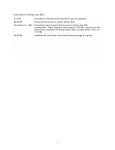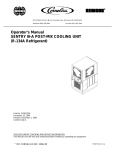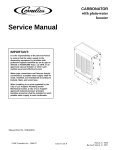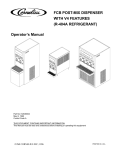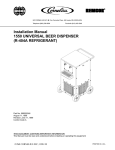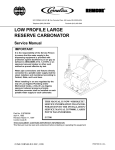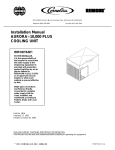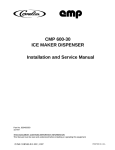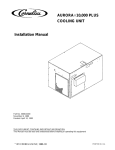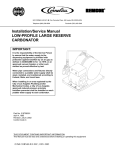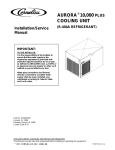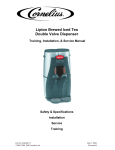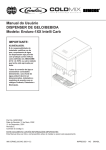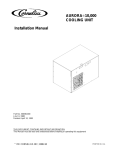Download Service Manual DECADE POST
Transcript
IMI CORNELIUS INC One Cornelius Place Anoka, MN 55303-6234 Telephone (800) 238-3600 Facsimile (612) 422-3246 Service Manual DECADE POST-MIX DISPENSER IMPORTANT: TO THE INSTALLER. It is the responsibility of the Installer to ensure that the water supply to the dispensing equipment is provided with protection against backflow by an air gap as defined in ANSI/ASME A112.1.2-1979; or an approved vacuum breaker or other such method as proved effective by test. Water pipe connections and fixtures directly connected to a potable water supply shall be sized, installed, and maintained according to Federal, State, and Local Codes. Part No. 315221004 January 24, 1994 Revised: May 21, 1998 Control Code B THIS DOCUMENT CONTAINS IMPORTANT INFORMATION This Manual must be read and understood before installing or operating this equipment IMI CORNELIUS INC; 1994–98 PRINTED IN U.S.A TABLE OF CONTENTS Page GENERAL INFORMATION . . . . . . . . . . . . . . . . . . . . . . . . . . . . . . . . . . . . . . . . . . . . . . . . . . 1 SAFETY INFORMATION . . . . . . . . . . . . . . . . . . . . . . . . . . . . . . . . . . . . . . . . . . . . . . . 1 RECOGNIZE SAFETY INFORMATION . . . . . . . . . . . . . . . . . . . . . . . . . . . . . . . 1 UNDERSTAND SIGNAL WORDS . . . . . . . . . . . . . . . . . . . . . . . . . . . . . . . . . . . . 1 FOLLOW SAFETY INSTRUCTIONS . . . . . . . . . . . . . . . . . . . . . . . . . . . . . . . . . 1 CLAIMS INSTRUCTIONS . . . . . . . . . . . . . . . . . . . . . . . . . . . . . . . . . . . . . . . . . . 1 WARRANTY REFERENCE INFORMATION . . . . . . . . . . . . . . . . . . . . . . . . . . . 1 UNIT DESCRIPTION . . . . . . . . . . . . . . . . . . . . . . . . . . . . . . . . . . . . . . . . . . . . . . . . . . . 2 THEORY OF OPERATION . . . . . . . . . . . . . . . . . . . . . . . . . . . . . . . . . . . . . . . . . . . . . . 3 UNITS WITH INTEGRAL (BUILT-IN) CARBONATORS . . . . . . . . . . . . . . . . . 4 UNITS WITH INTEGRAL (BUILT-IN) CARBONATORS AND SYRUP PUMPS . . 4 UNITS WITH 3–2–1 COIL CONFIGURATIONS (REQUIRING CONNECTION TO REMOTE CARBONATORS) . . . . . . . . . . . . . . . . . . . . . . . . . . . . . . . . . . . . . . . . . . . . . 4 UNIT SHUT-DOWN AND START-UP PROCEDURES . . . . . . . . . . . . . . . . . . . . . . 4 UNIT SHUT-DOWN PROCEDURE. . . . . . . . . . . . . . . . . . . . . . . . . . . . . . . . . . . 4 UNIT START-UP PROCEDURE. . . . . . . . . . . . . . . . . . . . . . . . . . . . . . . . . . . . . . 5 “SLEEP TIME” . . . . . . . . . . . . . . . . . . . . . . . . . . . . . . . . . . . . . . . . . . . . . . . . . . . . 5 OPERATING CONTROLS . . . . . . . . . . . . . . . . . . . . . . . . . . . . . . . . . . . . . . . . . . . . . . 11 SERVICE AND MAINTENANCE . . . . . . . . . . . . . . . . . . . . . . . . . . . . . . . . . . . . . . . . . . . . . 13 HOOD AND FRONT PANEL REMOVAL . . . . . . . . . . . . . . . . . . . . . . . . . . . . . . . . . . 13 HOOD REMOVAL . . . . . . . . . . . . . . . . . . . . . . . . . . . . . . . . . . . . . . . . . . . . . . . . . 13 FRONT ACCESS PANEL REMOVAL . . . . . . . . . . . . . . . . . . . . . . . . . . . . . . . . . 13 PERIODIC INSPECTION . . . . . . . . . . . . . . . . . . . . . . . . . . . . . . . . . . . . . . . . . . . . . . . 13 ADJUSTING CARBONATOR CO2 REGULATOR . . . . . . . . . . . . . . . . . . . . . . . . . . 14 ADJUSTING CO2 REGULATOR FOR BAG-IN-BOX SYRUP SYSTEM . . . . . . . 14 ADJUSTING SUGAR SYRUP TANKS SECONDARY CO2 REGULATORS . . . . 15 ADJUSTING LOW-CALORIE (DIET) SYRUP TANK SECONDARY CO2 REGULATOR . . . . . . . . . . . . . . . . . . . . . . . . . . . . . . . . . . . . . . . . . . . . . . . . . . . . . . . . . 15 MEASURING AND ADJUSTING DISPENSING VALVE CARBONATED WATER FLOW RATE . . . . . . . . . . . . . . . . . . . . . . . . . . . . . . . . . . . . . . . . . . . . . . . . . . . . . . . . . . 15 SF-1 DISPENSING VALVE . . . . . . . . . . . . . . . . . . . . . . . . . . . . . . . . . . . . . . . . . 15 LEV DISPENSING VALVE . . . . . . . . . . . . . . . . . . . . . . . . . . . . . . . . . . . . . . . . . . 16 ADJUSTING DISPENSING VALVE WATER-TO-SYRUP “RATIO” OF DISPENSED PRODUCT . . . . . . . . . . . . . . . . . . . . . . . . . . . . . . . . . . . . . . . . . . . . . . . . 17 SF-1 DISPENSING VALVE . . . . . . . . . . . . . . . . . . . . . . . . . . . . . . . . . . . . . . . . . 17 LEV DISPENSING VALVE . . . . . . . . . . . . . . . . . . . . . . . . . . . . . . . . . . . . . . . . . . 18 CLEANING AND SANITIZING . . . . . . . . . . . . . . . . . . . . . . . . . . . . . . . . . . . . . . . . . . . 18 DAILY CLEANING OF UNIT . . . . . . . . . . . . . . . . . . . . . . . . . . . . . . . . . . . . . . . . 18 SANITIZING POST-MIX SYRUP SYSTEMS . . . . . . . . . . . . . . . . . . . . . . . . . . 19 CLEANING DROP-IN REFRIGERATION ASSEMBLY CONDENSER COIL . . . . 21 CHECKING ICE WATER BATH . . . . . . . . . . . . . . . . . . . . . . . . . . . . . . . . . . . . . . . . . . 22 CLEANING WATER TANK . . . . . . . . . . . . . . . . . . . . . . . . . . . . . . . . . . . . . . . . . . . . . . 23 CARBONATOR WATER PUMP YEARLY MAINTENANCE OR AFTER WATER SYSTEM DISRUPTION . . . . . . . . . . . . . . . . . . . . . . . . . . . . . . . . . . . . . . . . . . . . . . . . . 25 SERVICING WATER PUMP WATER INLET STRAINER SCREEN . . . . . . . 25 i 315221004 TABLE OF CONTENTS (cont’d) Page SERVICING DOUBLE LIQUID CHECK VALVE ASSEMBLY . . . . . . . . . . . . . 27 SERVICING CO2 SYSTEM CO2 GAS CHECK VALVES . . . . . . . . . . . . . . . . . . . . 29 SERVICING UNIT CO2 INLET LINE GAS CHECK VALVE (UNIT WITH INTEGRAL CARBONATOR) . . . . . . . . . . . . . . . . . . . . . . . . . . . . . . . . . . . . . . . . . . . . . 29 REPLENISHING CO2 SUPPLY . . . . . . . . . . . . . . . . . . . . . . . . . . . . . . . . . . . . . . . . . . 30 REPLENISHING SYRUP SUPPLY . . . . . . . . . . . . . . . . . . . . . . . . . . . . . . . . . . . . . . . 31 SYRUP TANK SYRUP SUPPLY . . . . . . . . . . . . . . . . . . . . . . . . . . . . . . . . . . . . . 31 BAG-IN-BOX SYRUP SUPPLY . . . . . . . . . . . . . . . . . . . . . . . . . . . . . . . . . . . . . . 32 SYRUP FLAVOR CHANGE . . . . . . . . . . . . . . . . . . . . . . . . . . . . . . . . . . . . . . . . . . . . . 32 SELECTING SLEEP MODE OPTIONS (UNITS WITH INTEGRAL CARBONATORS) . . . . . . . . . . . . . . . . . . . . . . . . . . . . . . . . . . . . . . . . . . . . . . . . . . . . . . 33 SELECTING “SLEEP MODE” OPTION . . . . . . . . . . . . . . . . . . . . . . . . . . . . . . . 33 SLEEP MODE OPTION . . . . . . . . . . . . . . . . . . . . . . . . . . . . . . . . . . . . . . . . . . . . 33 ACTIVATING PLAIN WATER PRESSURE BOOSTER OR PLAIN WATER WAKEUP OPTIONS . . . . . . . . . . . . . . . . . . . . . . . . . . . . . . . . . . . . . . . . . . . . . . . . . . . . 34 PLAIN WATER PRESSURE BOOSTER OPTION . . . . . . . . . . . . . . . . . . . . . . 34 PLAIN WATER WAKEUP OPTION . . . . . . . . . . . . . . . . . . . . . . . . . . . . . . . . . . . 34 TROUBLESHOOTING . . . . . . . . . . . . . . . . . . . . . . . . . . . . . . . . . . . . . . . . . . . . . . . . . . . . . . 39 TROUBLESHOOTING POST-MIX SYSTEM . . . . . . . . . . . . . . . . . . . . . . . . . . . . . . . 39 WATER-TO-SYRUP “RATIO” TOO LOW OR TOO HIGH. . . . . . . . . . . . . . . . 39 ADJUSTMENT OF DISPENSING VALVE SYRUP FLOW REGULATOR DOES NOT INCREASE TO DESIRED WATER-TO-SYRUP “RATIO”. . . . . . . . . . . . 39 ADJUSTMENT OF DISPENSING VALVE SYRUP FLOW REGULATOR DOES NOT DECREASE TO DESIRED WATER-TO-SYRUP “RATIO”. . . . . . . . . . . 40 DISPENSED PRODUCT CARBONATION TOO LOW. . . . . . . . . . . . . . . . . . . 40 DISPENSED PRODUCT COMES OUT OF DISPENSING VALVE CLEAR BUT FOAMS IN CUP OR GLASS. . . . . . . . . . . . . . . . . . . . . . . . . . . . . . . . . . . . . . . . . 40 DISPENSED PRODUCT PRODUCES FOAM AS IT LEAVES DISPENSING VALVE. . . . . . . . . . . . . . . . . . . . . . . . . . . . . . . . . . . . . . . . . . . . . . . . . . . . . . . . . . . . 40 NO PRODUCT DISPENSED FROM ALL DISPENSING VALVES. . . . . . . . . 41 ONLY CARBONATED WATER DISPENSED. . . . . . . . . . . . . . . . . . . . . . . . . . . 41 ONLY SYRUP DISPENSED. . . . . . . . . . . . . . . . . . . . . . . . . . . . . . . . . . . . . . . . . 41 CARBONATOR NOT OPERATING. . . . . . . . . . . . . . . . . . . . . . . . . . . . . . . . . . . 41 REFRIGERATION COMPRESSOR DOES NOT OPERATE. . . . . . . . . . . . . 42 COMPRESSOR WILL NOT STOP AFTER SUFFICIENT ICE BANK IS PRODUCED. . . . . . . . . . . . . . . . . . . . . . . . . . . . . . . . . . . . . . . . . . . . . . . . . . . . . . 43 COMPRESSOR OPERATES CONTINUOUSLY BUT DOES NOT FORM SUFFICIENT ICE BANK. . . . . . . . . . . . . . . . . . . . . . . . . . . . . . . . . . . . . . . . . . . . 43 AGITATOR MOTOR NOT OPERATING. . . . . . . . . . . . . . . . . . . . . . . . . . . . . . . 43 WARRANTY . . . . . . . . . . . . . . . . . . . . . . . . . . . . . . . . . . . . . . . . . . . . . . . . . . . . . . . . . . . . . . 45 LIST OF FIGURES DECADE SIX-FLAVOR UNIT SHOWN . . . . . . . . . . . . . . . . . . . . . . . . . . . . . . . . . . . . 2 FIGURE 1. OPTIONAL DISPENSING VALVES DISPENSING CONFIGURATIONS . . . . . . . . . . . . . . . . . . . . . . . . . . . . . . . . . . . . . . . . . . . . . . . . . . . . 6 FIGURE 2. FLOW DIAGRAM (SIX-FLAVOR UNIT WITH INTEGRAL (BUILT-IN) CARBONATOR SHOWN) . . . . . . . . . . . . . . . . . . . . . . . . . . . . . . . . . . . . . . . . . . . . . . . 7 315221004 ii TABLE OF CONTENTS (cont’d) Page LIST OF FIGURES (CONT’D) FIGURE 3. FLOW DIAGRAM (SIX-FLAVOR UNIT [P/N 475136120] WITH INTEGRAL (BUILT-IN) CARBONATOR SHOWN) . . . . . . . . . . . . . . . . . . . . . . . . . . . . . . . . . . . . . 8 FIGURE 4. FLOW DIAGRAM (SIX-FLAVOR UNIT WITH INTEGRAL CARBONATOR AND BUILT-IN SYRUP PUMPS) . . . . . . . . . . . . . . . . . . . . . . . . . . . . . . . . . . . . . . . . . 9 FIGURE 5. FLOW DIAGRAM (SIX-FLAVOR UNIT WITH 3–2–1 COIL CONFIGURATION REQUIRING CONNECTION TO REMOTE CARBONATOR) 10 FIGURE 6. PARTS IDENTIFICATION (SIX-FLAVOR UNIT W/SYRUP PUMPS SHOWN) . . . . . . . . . . . . . . . . . . . . . . . . . . . . . . . . . . . . . . . . . . . . . . . . . . . . . . . . . . . . . 11 FIGURE 7. WIRING DIAGRAM . . . . . . . . . . . . . . . . . . . . . . . . . . . . . . . . . . . . . . . . . 37 FIGURE 8. CONTROL BOARD DIAGNOSTIC DECAL . . . . . . . . . . . . . . . . . . . . . 38 LIST OF TABLES TABLE 1. DESIGN DATA . . . . . . . . . . . . . . . . . . . . . . . . . . . . . . . . . . . . . . . . . . . . . . . iii 2 315221004 GENERAL INFORMATION SAFETY INFORMATION RECOGNIZE SAFETY INFORMATION This is the safety-alert symbol. When you see this symbol on our machine or in this manual be alert to the potential for personal injury. Follow recommended precautions and safe operating practices. UNDERSTAND SIGNAL WORDS A signal word - DANGER, WARNING, OR CAUTION is used with the safety-alert symbol. DANGER identifies the most serious hazards. DANGER Safety signs with signal word DANGER or WARNING are typically near specific hazards. WARNING General precautions are listed on CAUTION safety signs. CAUTION also calls attention to safety messages in this manual. CAUTION FOLLOW SAFETY INSTRUCTIONS Carefully read all safety messages in this manual and on your unit. Keep safety signs in good condition. Replace missing or damaged safety signs. Learn how to operate the machine and how to use the controls properly. Do not let anyone operate the machine without instructions. Keep the equipment in proper working condition. Unauthorized modifications to the equipment may impair the function and/or safety and affect equipment life. CLAIMS INSTRUCTIONS Claims: In the event of shortage, notify the carrier as well as IMI Cornelius Inc. immediately. In the event of damage, notify the carrier. IMI Cornelius Inc. is not responsible for damage occurring in transit, but will gladly render assistance necessary to pursue your claim. Merchandise must be inspected for concealed damage within 15 days of receipt. WARRANTY REFERENCE INFORMATION (to be filled out by Service Person) Unit Part Number Serial Number Install Date: Local Authorized Service Center: IMPORTANT: To the user of this manual - This manual is a guide for servicing and maintaining this equipment. Refer to table of contents for page location of detailed information pertaining to questions that arise during service and maintenance or troubleshooting of this equipment. 1 315221004 CAUTION: Before shipping, storing, or relocating Unit, syrup systems must be sanitized and all sanitizing solution must be purged from syrup coils. All water must be purged from carbonated and plain water systems and ice bank melted and all water drained from water tank. A freezing ambient environment will cause residual water remaining inside Unit to freeze resulting in damage to internal components. 315221004 2 UNIT DESCRIPTION The Units are in three configurations. The first model, either a five or a six-flavor, is equipped with an integral (built-in) carbonator. The second model, either a four, five, or a six-flavor, is equipped with an integral (built-in) carbonator and built-in syrup pumps that provide syrup to the Unit. The third model, also a five or six-flavor, requires connection to a remote carbonator. CARBONATED WATER TANK DECADE SIX-FLAVOR UNIT SHOWN Table 1. Design Data Unit Part Numbers: (see Note) 115V, 60HZ 5-FL Remote Carbonator (3–2–1 Coil Configuration) 6-FL Remote Carbonator (3–2–1 Coil Configuration) 5-Fl Integral Carbonator 6-Fl Integral Carbonator 5-Fl Integral Carbonator W/Syrup Pumps 6-Fl Integral Carbonator W/Syrup Pumps 230V, 50Hz 5-FL Remote Carbonator (3–2–1 Coil Configuration) 6-FL Remote Carbonator (3–2–1 Coil Configuration) 5-Fl Integral Carbonator 4-Fl Integral Carbonator 5-Fl Integral Carbonator 6-Fl Integral Carbonator 5-Fl Integral Carbonator 6-Fl Integral Carbonator 6-Fl Integral Carbonator 6-Fl Integral Carbonator, Low-carb No. 4 dispensing valve (CE approved) 5-Fl Integral Carbonator W/Syrup Pumps 6-Fl Integral Carbonator W/Syrup Pumps 230V, 60Hz (High-Torque Start) 5-FL Remote Carbonator (3–2–1 Coil Configuration) 6-FL Remote Carbonator (3–2–1 Coil Configuration) 5- Fl Integral Carbonator 6-Fl Integral Carbonator 5-Fl Integral Carbonator W/Built-In Syrup Pumps 6-Fl Integral Carbonator W/Built-In Syrup Pumps 3 426005 426006 426015 426016 426025 426026 475005 475006 475015 475014 475015 475016 475115 475116 475126 417536 475025 475026 476005 476006 476015 476016 476025 476026 315221004 NOTE: The five and six-flavor remote carbonator (3–2–1 coil configuration) models require a remote carbonator be connected to the dispenser to provide the carbonated water to the dispenser. The five and six-flavor Integral Models have an integral (built-in) carbonator that provides carbonated water for the dispenser. Table 1. Design Data (cont’d) Weights (approx): Integral (Built-In) Carbonator Unit Remote Carbonator Unit (3–2–1 Coil Configuration) Ice Bank Weight 141 pounds 121 pounds 32 pounds Unit Capacity Water Tank (No Ice Bank) Integral Carbonator Water Pump Integral Carbonator Water Tank Reserve 10 gallons 100 GPH 52 oz Overall Dimensions: Width Height Depth 18 inches 26 inches 24.5 inches Dispensing Rate: Four 12-oz Drinks/Min @ 40° F or below in 75° F Ambient. Four 12-oz Drinks/Min @ 40° F or below in 90° F Ambient. *NOTE: Number of 12-oz drinks dispensed 40 F or below (Starting With Stabilized Ice) Refrigeration System Refrigerant Requirement (R-134A) *225 *100 6.875 oz Ambient Operating Temperature 40° F to 110° F Electrical Requirements: Operating Voltage Current Draw See Unit Nameplate See Unit Nameplate THEORY OF OPERATION NOTE: Refer to Figure 1 for optional dispensing valves dispensing configurations for UNITS WITH INTEGRAL (BUILT–IN) CARBONATORS (see Figure 2 and 3) and UNITS WITH INTEGRAL (BUILT–IN) CARBONATORS AND SYRUP PUMPS (see Figure 4). The five-flavor Units may be configured to dispense all carbonated and no still (noncarbonated) drinks or four carbonated and one noncarbonated drink. The six-flavor Units may be configured to dispense five carbonated and one noncarbonated drinks, four carbonated and two noncarbonated drinks, or six carbonated and no non-carbonated drinks. 315221004 4 UNITS WITH INTEGRAL (BUILT-IN) CARBONATORS Standard Units with Integral (Built-In Carbonators. (see Figure 2) A syrup tanks system or a bag–in–box syrup system may be connected to these Units to provide syrup supply to the Units. Plain water enters the integral (built-in) carbonator carbonated water tank and is carbonated by regulated CO2 gas pressure also entering the tank. When dispensing valve is opened, syrup is pushed through the Unit cooling coils, and on to the dispensing valve. Carbonated water tank CO2 gas head pressure pushes carbonated water from the tank to the dispensing valve. Syrup and carbonated water meet simultaneously at the dispensing valve resulting in a carbonated drink being dispensed. A still (noncarbonated) drink is dispensed in the same manner as the carbonated drink except plain water is substituted for carbonated water. Dispenser P/N 475136120 (Six-Flavor Unit with Integral (Built-In) Carbonator with Low-Carb No. 4 Dispensing Valve). See Figure 3) This Unit operates in much the same way as the standard Units with integral (built-in) carbonators . No. 4 dispensing valve is set up to dispense a low-carb drink by connecting a low-carb remote carbonator to the No. 4 dispensing valve water inlet line or plain water may be connected to the water line to dispense a still (non-carbonated) drink. UNITS WITH INTEGRAL (BUILT-IN) CARBONATORS AND SYRUP PUMPS (See Figure 4) A CO2 cylinder delivers carbon dioxide (CO2) gas through an adjustable CO2 regulator to the syrup pumps and also the integral (built-in) carbonator located inside the Unit. Plain water enters the carbonator carbonated water tank and is carbonated by regulated CO2 gas pressure also entering the tank. Opening one of the dispensing valves causes the CO2 operated syrup pump associated with that valve to operate which pumps syrup from the syrup bag-in-box, through the Unit cooling coil, and on to the dispensing valve. Carbonated water tank CO2 gas head pressure pushes carbonated water from the tank to the dispensing valve. Syrup and carbonated water meet simultaneously at the dispensing valve resulting in a carbonated drink being dispensed. A still (non-carbonated) drink is dispensed in the same manner as the carbonated drink except plain water is substituted for carbonated water. UNITS WITH 3–2–1 COIL CONFIGURATIONS (REQUIRING CONNECTION TO REMOTE CARBONATORS) (see Figure 5) The three Unit water inlet lines may be connected to either plain water or carbonated water (remote carbonator) source lines. Plain or carbonated water connected to No. 1 water inlet line will allow No. 5 valve to dispense either a still (noncarbonated) or a carbonated drink. Plain or carbonated water connected to No. 2 water inlet line will allow No. 3 and No. 4 valves to dispense either still (noncarbonated) or carbonated drinks. Plain or carbonated water connected to No. 3 water inlet line will allow No. 1, 2, and No. 6 valves to either dispense still (noncarbonated) or carbonated drinks. A syrup tank system or a syrup bag–in–box/syrup pump system may be connected to the Unit to provide syrup supply to the Unit. UNIT SHUT-DOWN AND START-UP PROCEDURES UNIT SHUT-DOWN PROCEDURE. 1. Place control board power switch in “OFF” position to shut the Unit down. THIS SWITCH IS AN ON-OFF SWITCH AND CONTROLS ONLY THE 24 VAC LOW VOLTAGE POWER SOURCE TO THE CONTROL BOARD. HIGH VOLTAGE IS STILL PRESENT INSIDE THE DISPENSER. USE CAUTION, UNPLUG UNIT POWER CORD FROM ELECTRICAL OUTLET BEFORE PERFORMING INTERNAL MAINTENANCE ON THE DISPENSER. 5 315221004 2. Unplug Unit power cord from electrical outlet. UNIT START-UP PROCEDURE. 1. Plug Unit power cord into electrical outlet. 2. Place control board power switch in “ON” position. After a two-minute built-in time delay, refrigeration compressor will start. “SLEEP TIME” During normal operation, if carbonator motor or refrigeration compressor have not operated for 10 minutes, Unit will go into “SLEEP TIME”. While Unit is in “SLEEP TIME”, agitator motor will operate every 10 minutes for 30 seconds, then stop. “SLEEP TIME” will continue until either the refrigeration compressor or the carbonator motor start, then agitator motor will operate continuously until both refrigeration compressor and carbonator motor have not operated again for 10 minutes. “SLEEP TIME” cycle will again occur. CONTROL BOARD POWER SWITCH 315221004 6 5 6 1 1 5 6 FIVE VALVES CARB FOUR VALVES CARB NO VALVES NON-CARB NO. 3 VALVE NON-CARB 5-FLAVOR WITH INTEGRAL (BUILT-IN) CARBONATOR 2 6 4 4 6 3 2 5 5 2 6 PART NO: 426015 426025 475015 475025 476015 476025 3 4 FIVE VALVES CARB FOUR VALVES CARB SIX VALVES CARB NO. 4 VALVE NON-CARB NO. 3 & 4 VALVES NON-CARB NO VALVES NON-CARB PART NO: 426016 426026 475016 475026 476016 476026 6-FLAVOR WITH INTEGRAL (BUILT-IN) CARBONATOR 5 6 2 6 FIVE VALVES CARB NO. 4 VALVE CUSTOM INDIVIDUAL SUPPLY COIL 5 FOUR VALVES CARB NO VALVES NON-CARB 6-FLAVOR UNIT (P/N 475136120) WITH INTEGRAL (BUILT-IN) CARBONATOR 4-FLAVOR UNIT (P/N 475514) WITH INTEGRAL (BUILT-IN) CARBONATOR Parts Identification for Optional Configurations Item P/N 1 2535 2 3 Description Item P/N Description Connector, Straight, Plain water 4 2484 Connector, Tee 2483 Connector, Elbow, Plain water 5 2649 Plug Assembly 2530 Tube, Straight, S/S 6 311765001 Dual Check Valve Assembly FIGURE 1. OPTIONAL DISPENSING VALVES DISPENSING CONFIGURATIONS Note: 1. ILLUSTRATIONS SHOW VIEW OF TUBING CONNECTIONS ON TOP FRONT OF THE WATER TANK. 2. ONNECTIONS REQUIRE LUBRICATION PRIOR TO ASSEMBLY. 7 315221004 31522004 PLAIN WATER COOLING COIL SYRUP COIL (6) 1 WATER PUMP AND MOTOR DOUBLE LIQUID CHECK VALVE 2 3 CARBONATED WATER TANK 4 CO2 CHECK VALVE PLAIN WATER INLET CO2 INLET 8 5 SYRUP INLETS (SEE NOTE) 6 DISPENSER NOTE: Syrup sources may either be a bag–in–box system or a syrup tanks system LINE LEGEND SYRUP PLAIN WATER CARB WATER CO2 FIGURE 2. FLOW DIAGRAM (SIX-FLAVOR UNIT WITH INTEGRAL (BUILT-IN) CARBONATOR SHOWN) DIET DRINK PLAIN WATER COOLING COIL SYRUP COIL (6) 1 WATER PUMP AND MOTOR DOUBLE LIQUID CHECK VALVE 2 3 CARBONATED WATER TANK STILL (NON-CARB OR LOW-CARB DRINK CO2 CHECK VALVE 4 PLAIN WATER INLET NO.4 DISPENSING VALVE WATER INLET (SEE NOTE 2) CO2 INLET 9 5 NOTE 1: The syrup sources may either be a bag–in–box system or a syrup tanks system SYRUP INLETS (SEE NOTE 1) 6 NOTE 2: The No. 4 dispensing valve water inlet may be connected to a low-carb carbonator for a low-carb drink to be dispensed from No. 4 dispensing valve or the water inlet line may be connected to filtered plain water to dispense a still (non-carbonated) drink from No. 4 dispensing valve. DISPENSER 315221001 LINE LEGEND SYRUP PLAIN WATER CARB WATER CO2 FIGURE 3. FLOW DIAGRAM (SIX-FLAVOR UNIT [P/N 475136120] WITH INTEGRAL (BUILT-IN) CARBONATOR SHOWN) 315221–004 PLAIN WATER COOLING COIL SYRUP COIL (6) 1 WATER PUMP AND MOTOR 2 DOUBLE LIQUID CHECK VALVE 3 CARBONATED WATER TANK 4 CO2 CHECK VALVE 10 PLAIN WATER INLET 5 CO2 INLET 6 NOTE: Syrup sources may either be a bag–in–box system or a syrup tanks system SYRUP PUMP (6) SYRUP INLETS (SEE NOTE) 1 LINE LEGEND SYRUP PLAIN WATER CARB WATER CO2 2 3 4 5 6 CO2 MANIFOLD DISPENSER FIGURE 4. FLOW DIAGRAM (SIX-FLAVOR UNIT WITH INTEGRAL CARBONATOR AND BUILT-IN SYRUP PUMPS) DISPENSER WATER COOLING COIL (4) SYRUP COIL (6) 1 NOTE: Syrup sources may either be a syrup bag–in–box system or a syrup tanks system 2 3 4 LINE LEGEND SYRUP PLAIN OR CARB WATER 11 5 6 PLAIN WATER OR CARBONATED WATER INLET LINES NO.3 WATER INLET LINE FOR VALVES NO. 1, 2, AND 6 3 2 1 1 2 3 4 5 6 NO.2 WATER INLET LINE FOR VALVES NO. 3 AND 4 SYRUP INLET LINES (SEE NOTE) 315221-004 NO.1 WATER INLET LINE FOR VALVE NO. 5 FIGURE 5. FLOW DIAGRAM (SIX-FLAVOR UNIT WITH 3–2–1 COIL CONFIGURATION REQUIRING CONNECTION TO REMOTE CARBONATOR) OPERATING CONTROLS DISPENSING VALVE LEVER: The dispensing valve lever, located on the HOOD SCREW bottom of the dispensing valve, need only be pressed with a cup or glass to dispense product. REFRIGERATION POWER SWITCH ACCESS HOLE KEY-LOCK SWITCH: The key-lock switch, located on bottom right side of the dispenser, prevents operation of the dispensing valves when switch is in the “OFF” position. This key-lock switch does not affect operation of the refrigeration system. CONTROL BOARD POWER SWITCH: The control board power switch is located on the top of the refrigeration assembly and is accessible through a hole in the top of the hood. THIS SWITCH IS AN ON-OFF SWITCH AND CONTROLS ONLY THE 24 VAC LOW VOLTAGE POWER SOURCE TO THE CONTROL BOARD. HIGH VOLTAGE IS STILL PRESENT INSIDE THE DISPENSER. USE CAUTION, UNPLUG UNIT POWER CORD FROM ELECTRICAL OUTLET BEFORE PERFORMING INTERNAL MAINTENANCE ON THE DISPENSER. CONTROL BOARD POWER SWITCH INTEGRAL CARBONATOR PUMP & MOTOR ASSEMBLY HOOD CONDENSER REFRIGERATION DECK LIFTING HANDLES DISPENSING VALVES (6) CUP REST VALVE MOUNTING BLOCK FRONT PANEL FILL HOLE PLUG CONNECTOR CARBONATOR MOTOR POWER CORD KEY-LOCK SWITCH DRIP TRAY DISPENSING VALVE LEVER FIGURE 6. PARTS IDENTIFICATION (SIX-FLAVOR UNIT W/SYRUP PUMPS SHOWN) 315221–002 12 THIS PAGE LEFT BLANK INTENTIONALLY 13 315221004 SERVICE AND MAINTENANCE CAUTION: Before shipping, storing, or relocating this Unit, the syrup systems must be sanitized and all sanitizing solution must be purged from the syrup systems. All water must also be purged from the plain and carbonated water systems. A freezing ambient environment will cause residual water in the Unit to freeze resulting in damage to internal components. HOOD AND FRONT PANEL REMOVAL HOOD REMOVAL Remove one screw securing hood on Unit, then lift hood straight up off Unit. FRONT ACCESS PANEL REMOVAL Remove front access panel by lifting panel up, then pull out on bottom. HOOD RETAINING SCREW HOOD FRONT ACCESS PANEL PERIODIC INSPECTION 1. Check refrigeration condenser coil for obstructions and dirt. DO NOT place objects on top of hood. Restricting circulating air in and out of Unit will decrease its cooling efficiency. 2. Check dispensing valves for dripping that indicates leaking and repair as necessary. CONDENSER DISPENSING VALVE 315221004 14 ADJUSTING CARBONATOR CO2 REGULATOR Unit with Integral (Built-in) Carbonator and Without Built-in Syrup Pumps Adjust CO2 regulator (see Figure 2) for the integral carbonator at a nominal 70-psig. CO2 PRESSURE TO THE CARBONATOR MUST NOT EXCEED 80-psig. Unit Connected To Remote Carbonator Refer to manual provided with the remote carbonator to adjust the CO2 regulator for operating pressure. PRIMARY CO2 REGULATOR TO CARBONATOR Unit with Integral (Built-In) Carbonator and Built-In Syrup Pumps. CO2 pressure to operate Unit equipped with an integral (built-in) carbonator and built-in syrup pumps is provided by a CO2 regulator in the system). The CO2 regulator provides regulated CO2 pressure to both the integral carbonator and also the built-in syrup pumps inside the Unit. Adjust the CO2 regulator to 70-PSI. DO NOT EXCEED MAXIMUM PRESSURE SPECIFIED ON THE SYRUP PUMPS. PRIMARY CO2 REGULATOR TO CARBONATOR AND SYRUP PUMPS ADJUSTING CO2 REGULATOR FOR BAG-IN-BOX SYRUP SYSTEM The CO2 regulator provides regulated CO2 pressure to both the integral carbonator and also the built-in syrup pumps inside the Unit. Adjust the primary CO2 regulator to 70-psi. DO NOT EXCEED MAXIMUM PRESSURE SPECIFIED ON THE SYRUP PUMPS. PRIMARY CO2 REGULATOR TO CARBONATOR AND SYRUP PUMPS 15 315221004 ADJUSTING SUGAR SYRUP TANKS SECONDARY CO2 REGULATORS Adjust sugar syrup tanks secondary CO2 regulator with 100-psi gauge at 40-psig for syrup lines up to 10 feet in length plus one pound for each additional length of 10 feet, plus one pound for each 2 feet of vertical lift. For example; if syrup line total length is 30 feet and total vertical lift is 6 feet, then 40-psig + 2-psig (1 pound for every 10 feet of length over 10 feet which is 20 feet) + 3-psig (1 pound for every 2 feet of vertical lift which is 6 feet); total equals 40 + 2 + 3 = 45-psig CO2 regulator setting. Loosen lock nut on CO2 regulator adjusting screw, turn adjusting screw to the right (clockwise) until gauge registers desired pressure, then tighten lock nut. SUGAR SYRUP TANKS CO2 REGULATOR ADJUSTING LOW-CALORIE (DIET) SYRUP TANK SECONDARY CO2 REGULATOR Adjust low-calorie (diet) soft drink tank secondary CO2 regulator with 30-psi gauge to 10-psig for syrup lines up to 30 feet in length. Syrup lines longer than 30 feet in length may require a slightly higher CO2 regulator setting to 12-psig maximum. Excessive CO2 pressure may cause low-calorie syrup calorie syrup carbonation resulting in foam. LOW-CALORIE (DIET) SYRUP TANK CO2 REGULATOR MEASURING AND ADJUSTING DISPENSING VALVE CARBONATED WATER FLOW RATE SF-1 DISPENSING VALVE 1. Remove the acorn nut securing the dispensing valve cover, then remove the cover. 315221004 16 2. Measure the carbonated water flow rate by dispensing carbonated water into a graduated cup for a set period of time. Factory-set flow rate is approximately 1.25 oz/sec. 3. Adjust the carbonated water flow regulator adjusting screw clockwise for a greater flow or counterclockwise for lesser flow. Limit your adjustment to 1/4-turn at a time, then recheck the flow rate. Only the carbonated water flow rate is to be adjusted now. Syrup flow rate is adjusted in the “Ratio Adjustment” section. + ACORN NUT – WATER FLOW ADJUSTMENT SCREW GRADUATED CUP LEV DISPENSING VALVE 1. Slide dispensing valve cover front panel up far enough to expose the valve water and syrup flow controls. 2. Remove dispensing valve nozzle by turning nozzle counterclockwise and pulling down. 3. Remove syrup diffuser by pulling straight down. 4. Install syrup separator on dispensing valve in place of the nozzle. 5. Measure the carbonated water flow rate by dispensing carbonated water into a graduated cup for a set period of time. Factory-set flow rate is approximately 1.25 ounces per second. 6. Adjust the carbonated water flow control adjusting screw clockwise for a greater flow or counterclockwise for lesser flow. Limit your adjustment to 1/4-turn at a time, then recheck the flow rate. Only the carbonated water flow rate is to be adjusted now. Syrup flow rate is adjusted in the “Ratio Adjustment” section. WATER ADJUSTMENT SCREW SYRUP DIFFUSER NOZZLE 17 315221004 ADJUSTING DISPENSING VALVE WATER-TO-SYRUP “RATIO” OF DISPENSED PRODUCT SF-1 DISPENSING VALVE NOTE: Do not adjust the ratio of syrup to water until the water flow rate is properly adjusted. Adjust the dispensed product Water-To-Syrup “Ratio” using Ratio Cup (P/N 311100000) and Syrup By-Pass Tube (P/N 319540000) as follows: 1. Install the syrup by-pass tube on the dispensing valve by pushing the rubber end of the by-pass tube up on the baffle inside the nozzle. NOTE: Refer to the manufacturer’s recommendations on the syrup package for the proper Water-To-Syrup “Ratio”. 2. Hold container under the dispensing valve nozzle and press the valve lever until syrup flows from the syrup by-pass tube. 3. Hold ratio cup under the dispensing valve so that the large water chamber of the cup is under the valve nozzle and the proper small chamber of the cup is under the by-pass tube. NOTE: Set the ratio cup on a level surface for this step. 4. Press the dispensing valve lever and dispense until large water chamber of the ratio cup is approximately 3/4 full of water. 5. Set the ratio cup on a level surface and observe the levels in the water and syrup chambers. 6. The ratio is correct when the water and syrup levels are even in both chambers. 7. If the syrup level is below that of the water, as in the illustration, then the syrup flow regulator must be adjusted clockwise to increase the syrup flow rate. If the syrup level is above that of the water, then the syrup flow regulator must be adjusted counterclockwise to decrease the syrup flow rate. 8. When making adjustments, always adjust the syrup flow regulator 1/4 turn at a time, then retest the ratio. Adjustments greater than 1/4 turn will only cause delays in reaching the desired ratio. WATER LEVEL SYRUP LEVEL NOZZLE BY-PASS TUBE + – WATER CHAMBER SYRUP CHAMBER (2) 315221004 18 SYRUP FLOW REGULATOR LEV DISPENSING VALVE Adjust the dispensed product Water-To-Syrup “Ratio” using ratio Cup and syrup separator as follows: 1. Remove dispensing valve nozzle by turning nozzle counterclockwise and pulling down. 2. Remove syrup diffuser by pulling straight down. SYRUP ADJUSTING SCREW WATER LEVEL SYRUP LEVEL SYRUP DIFFUSER NOZZLE 3. Install syrup separator on dispensing valve in place of the nozzle. NOTE: Refer to the manufacturer’s recommendations on the syrup package for the proper Water-To-Syrup “Ratio”. 4. Hold container under the dispensing valve nozzle and press the valve lever until syrup flows from the syrup separator. 5. Hold ratio cup under the dispensing valve syrup separator, then press dispensing valve lever and dispense until large water chamber of the ratio cup is approximately 3/4 full of water. NOTE: Set the ratio cup on a level surface for this step. 6. The ratio is correct when the water and syrup levels are even in both chambers. 7. If the syrup level is below that of the water, as in the illustration, then the syrup flow control must be adjusted clockwise to increase the syrup flow rate. If the syrup level is above that of the water, then the syrup flow control must be adjusted counterclockwise to decrease the syrup flow rate. 8. When making adjustments, always adjust the syrup flow control 1/4 turn at a time, then retest the ratio. Adjustments greater than 1/4 turn will only cause delays in reaching the desired ratio. CLEANING AND SANITIZING DAILY CLEANING OF UNIT 1. Remove cup rest from the drip tray. 2. Wash drip tray in place on the Unit, then rinse drip tray with hot water allowing water to drain out through the drain hose. 3. Wash cup rest, then rinse the cup rest with clean water. Install cup rest in the drip tray. 19 315221004 4. Clean all external surfaces of the Unit with a sponge. Rinse out the sponge with clean water, then wring excess water out of the sponge and wipe off all external surfaces on the Unit. Wipe Unit dry with a clean soft cloth. DO NOT USE ABRASIVE CLEANERS. 5. Remove nozzle and syrup diffusers from the dispensing valves. Place nozzles and syrup diffusers in sanitizing solution. 6. Wash the nozzles and syrup diffusers in sanitizing solution, then rinse them with potable water. 7. Re-install nozzles and syrup diffusers back on the dispensing valves. SANITIZING POST-MIX SYRUP SYSTEMS IMPORTANT: Only qualified Service Personnel should perform sanitizing procedure on the post-mix syrup systems. The post-mix syrup systems should be sanitized every 90-days using a non-scented household liquid bleach containing a 5.25 % sodium hypochlorite concentration. Proceed as follows to sanitize the post-mix syrup systems. 1. Disconnect syrup supplies from syrup systems. 2. Rinse quick disconnects (syrup tanks systems) or bag-in-box connectors (syrup bag-in-box systems) in warm potable water. STEP 1. WASH SYRUP SYSTEMS 3. Using a clean syrup tank (syrup tank system) or a five-gallon container (bag-in-box system), prepare a full tank or container of liquid dishwasher detergent by using 70 F (21 C) to 100 F (38 C) potable water and 0.5 oz. (15 ml) of liquid dishwasher detergent to one gallon of potable water. Stir detergent solution to thoroughly mix the solution. 4. Syrup Tank Systems. A. Observe and note CO2 pressure setting on the syrup tanks CO2 regulator, then re-adjust CO2 regulator to 60 to 80-psi. Pressurize syrup tank containing detergent solution to 60 to 80-psi. B. Connect detergent solution tank, pressurized at 60 to 80-psi, into one of the syrup systems. Bag-in Box Syrup Systems. C. Install bag valves, cut from empty bag-in-box syrup containers, on ends of syrup containers syrup outlet tubes connectors. D. Place all syrup outlet tubes, with bag valves on their ends, in container containing detergent solution. 5. Flush the syrup system and dispensing valve as follows: A. Place waste container under applicable dispensing valve. B. Activate the dispensing valve for one minute to purge all syrup and flush out the syrup system. C. Continue to activate the dispensing valve in cycles (“ON” for 15-seconds, “OFF”, then “ON” for 15-seconds). Repeat “ON” and “OFF” cycles for 15-cycles. 6. Connect detergent solution to the remaining syrup systems and flush syrup out of the syrup systems as instructed in step 5 preceding. 7. Remove detergent solution source from the syrup system. STEP 2. FLUSH SYRUP SYSTEMS 8. Syrup Tank Systems. Connect syrup tank containing potable water, pressurized at 60 to 80-psi, into one of the syrup systems. 20 315221004 Bag-in-Box Syrup System. Fill five-gallon container with potable water, then place all bag-in-box syrup containers syrup outlet tubes in container containing potable water. 9. Flush detergent solution out of the syrup system and dispensing valve as follows: A. Place waste container under applicable dispensing valve. B. Activate the dispensing valve for one minute to purge all detergent solution and flush out the syrup system. C. Continue to activate the dispensing valve in cycles (“ON” for 15-seconds, “OFF”, then “ON” for 15-seconds). Repeat “ON” and “OFF” cycles for 15-cycles. 10. Connect potable water source to the remaining syrup systems and flush detergent solution out of the syrup systems as instructed in step 9 preceding. 11. Remove potable water source from the syrup system. STEP 3. SANITIZE SYRUP SYSTEMS 12. Using a clean syrup tank (syrup tanks system) or a five-gallon container (bag-in-box system), prepare sanitizing solution using 70 F (21 C) to100 F (38 C) potable water and 0.5 oz. (15 ml) of non-scented household liquid bleach that contains a 5.25 % sodium hypochlorite concentration to one gallon of potable water. This mixture must not exceed 200 PPM of chlorine. Stir sanitizing solution to thoroughly mix. 13. Syrup Tank Systems. Connect sanitizing solution tank, pressurized at 60 to 80-psi, into one of the syrup systems. Bag-in-Box Syrup System. Place all bag-in-box syrup containers syrup outlet tubes in container containing sanitizing solution. 14. Sanitize the syrup system and dispensing valve as follows: A. Place waste container under applicable dispensing valve. B. Activate the dispensing valve for one minute to purge all water from and install sanitizing solution in the syrup system and dispensing valve. C. Continue to activate the dispensing valve in cycles (“ON” for 15-seconds, “OFF”, then “ON” for 15-seconds). Repeat “ON” and “OFF” cycles for 15-cycles. 15. Repeat steps13 and 14 to flush water out of and install sanitizing solution in the remaining syrup systems and dispensing valves. 16. Remove sanitizing solution source from the syrup system. 17. Allow sanitizing solution to remain in the syrup systems for not less than 10 or no more than 15-minutes (max.) contact time. STEP 4. WATER FLUSH SYRUP SYSTEMS WARNING: Flush sanitizing solution from the syrup systems as instructed. Residual sanitizing solution left in the syrup systems could create a health hazard. 18. Fill syrup tank (syrup tank system) or a five-gallon container (bag-in-box system) with potable water. 19. Syrup Tank Systems. Connect syrup tank containing potable water, pressurized at 60 to 80-psi, into one of the syrup systems. Bag-in-Box Syrup System. 21 315221004 Place all bag-in-box syrup containers syrup outlet tubes in container containing potable water. 20. Flush sanitizing solution from the syrup system and the dispensing valve as follows: A. Place waste container under applicable dispensing valve. B. Activate the dispensing valve for one minute to purge all sanitizing solution out of the syrup system and the dispensing valve. C. Continue to activate the dispensing valve in cycles (“ON” for 15-seconds, “OFF”, then “ON” for 15-seconds). Repeat “ON” and “OFF” cycles for 15-cycles. 21. Repeat steps 19 and 20 preceding to purge sanitizing solution out of the remaining syrup systems and dispensing valves. 22. Remove potable water source from the syrup system. STEP 5. PURGE WATER OUT OF SYRUP SYSTEMS (RESTORE OPERATION) 23. Syrup Tank Systems. A. Noting syrup tanks CO2 regulator pressure setting observed in step 4 preceding, readjust CO2 regulator to the observed pressure setting, B. Connect tanks containing syrup into syrup systems. Bag-in-Box Syrup System. C. Remove all bag valves from bag-in-box syrup containers outlet tubes connectors. D. Connect bag-in-box syrup containers into the syrup systems. 24. Place waste container under dispensing valves. Dispense from all dispensing valves to permit syrup to purge all potable water from the syrup systems and the dispensing valves. Continue to dispense from the dispensing valves until only syrup is dispensed from the syrup systems and valves. WARNING: To avoid possible personal injury or property damage, do not attempt to remove the syrup tank cover until CO2 pressure has been released from the tank. 25. Dispose of waste sanitizing solution in a sanitary sewer, not in a storm drain, then thoroughly rinse the inside and the outside of the container that was used for sanitizing solution to remove all sanitizing solution residue. CLEANING DROP-IN REFRIGERATION ASSEMBLY CONDENSER COIL Excessive accumulation of dust, lint, and grease on the drop-in refrigeration assembly condenser coil will restrict air flow through the coil and cause a loss of cooling efficiency. Perform the following procedure to clean the condenser coil. CAUTION: The refrigeration assembly condenser coil must be cleaned every 30 days. Excessive accumulation of dust, lint, and grease on condenser coil will restrict air flow through the coil and cause refrigeration system to overheat. Operating refrigeration system in an overheated condition will eventually lead to compressor failure and will automatically void factory warranty. Clean condenser coil as follows: 1. Place control board power switch, located under access hole in top of the hood, in “OFF” position. THIS SWITCH IS AN ON-OFF SWITCH AND CONTROLS ONLY THE 24 VAC LOW VOLTAGE POWER SOURCE TO THE CONTROL BOARD. HIGH VOLTAGE IS STILL PRESENT INSIDE THE DISPENSER. USE CAUTION, UNPLUG UNIT POWER CORD FROM ELECTRICAL OUTLET BEFORE PERFORMING INTERNAL MAINTENANCE ON THE DISPENSER. 2. Unplug Unit power cord from electrical outlet. 3. Loosen screw securing hood to Unit, then lift hood up to remove. 4. Unplug condenser fan motor power cord connector from mating Unit wiring harness connector. 315221004 22 5. Remove screw securing condenser fan motor bracket, then drop condenser fan motor down and remove from Unit. 6. Vacuum or use a soft brush to clean underside of the condenser coil. If available, use low-pressure compressed air. CONDENSER COIL CONTROL BOARD POWER SWITCH RETAINING SCREW CONDENSER FAN MOTOR BRACKET CONDENSER FAN MOTOR 7. Clean dust and dirt from around the top of the refrigeration assembly. 8. Install condenser fan motor in Unit and secure with screw removed in step 5. 9. Plug condenser fan motor power cord connector into Unit wiring harness mating connector. 10. Plug Unit power cord into electrical outlet. 11. Place control board power switch in “ON” position. Refrigeration compressor will start after a two-minute built-in time delay. 12. Install hood on Unit and secure with screw. CHECKING ICE WATER BATH A “gurgle” heard from Unit indicates water level in the water tank is low and more water should be added to the tank for maximum cooling. Before adding more water, ice water bath and ice bank should be checked for cleanliness and water tank coils checked for excessive mineral deposit build–up. 1. Place drop-in refrigeration assembly power switch , located under access hole on top of the hood, in the “OFF” position. THIS SWITCH IS AN ON-OFF SWITCH AND CONTROLS ONLY THE 24-VAC LOW VOLTAGE POWER SOURCE TO THE CONTROL BOARD. HIGH VOLTAGE IS STILL PRESENT INSIDE THE DISPENSER. USE CAUTION, UNPLUG UNIT POWER CORD FROM ELECTRICAL OUTLET BEFORE PERFORMING INTERNAL MAINTENANCE ON THE DISPENSER. 23 315221004 2. Unplug Unit power cord from electrical outlet. 3. Loosen screw securing hood to Unit, then lift hood up to remove. 4. Remove plug from drop-in refrigeration assembly platform water fill hole . 5. Using a flashlight, inspect ice water bath and ice bank for cleanliness. Ice water bath should be clear and ice bank free of foreign particles. 6. If cleaning of water tank is necessary, refer to CLEANING WATER TANK in this section. NOTE: Use low-mineral content water if a local water problem exists. Do not use distilled or deionized water. 7. Fill water tank with clean water until water runs out of water tank overflow hose into the drip tray. 8. Install plug in water fill hole. 9. Install Unit hood and secure with screw. 10. Plug Unit power cord into electrical outlet. 11. Place control board power switch in “ON” position. Refrigeration compressor will start after a two-minute built-in time delay. If water in water bath is above temperature of 60° F, the agitator motor will not operate until the refrigeration system has cooled the water down to below 60° F. Agitator motor will then start and operate. CAUTION: Never use an ice pick or other instrument to remove ice from the drop-in refrigeration assembly evaporator coils. Such practice can result in a punctured refrigeration circuit. CLEANING WATER TANK NOTE: The following instructions pertain to cleaning the water tank on Dispenser models with integral (built-in) carbonators. Water tank cleaning instructions for the nonintegral (Dispensers requiring connection to a remote carbonator) Dispenser models are nearly the same with exception of excluding instructions pertaining to the integral carbonator. 315221004 24 1. Unplug Unit power cord from electrical outlet. 2. Extend water tank drain hose to a waste container or a floor drain. Remove plug from end of the drain hose and allow water tank to drain. REFRIGERATION POWER CORD CONTROL BOARD POWER SWITCH REFRIGERATION DECK LIFTING HANDLES CARBONATOR TANK SENSOR WIRING HARNESS CONDENSER CARBONATOR MOTOR POWER CORD FILL HOLE PLUG WATER TANK FILL HOLE DISPENSING VALVE (6) DISPENSING VALVE WIRE HARNESS CARBONATOR TANK SENSOR PROBE KEY-LOCK SWITCH CARBONATOR TANK RELIEF VALVE INTEGRAL CARBONATOR PUMP AND MOTOR ASS’Y FRONT PANEL 3. Remove hood by removing one screw on top of hood, then lift hood straight up off Unit. 4. Disconnect the drop-in refrigeration assembly power cord and the carbonator tank sensor wiring harness connectors from their mating connectors. 5. Disconnect the carbonator motor power cord connector and the Dispensing valves wiring harness connector from mating connectors on drop-in refrigeration assembly side panel. 6. Remove three screws securing the drop-in refrigeration assembly in the lower cabinet, then very carefully lift the refrigeration assembly up out of the cabinet. 7. Allow ice bank to melt. Hot water may be used to speed melting. NEVER USE AN ICE PICK OR OTHER INSTRUMENT TO REMOVE ICE FROM THE DROP-IN REFRIGERATION ASSEMBLY EVAPORATOR COILS. SUCH PRACTICE CAN RESULT IN A PUNCTURED REFRIGERATION CIRCUIT. 8. Using a fiber brush, very carefully clean mineral deposit build-up from agitator motor shaft and ice bank sensor. 9. Wash inside of the water tank and the drop-in refrigeration assembly evaporator coils, then rinse with clean water. 10. Install the plug securely in end of the water tank drain hose. 11. Very carefully, install the drop-in refrigeration assembly in the Unit cabinet and secure with three screws. 25 315221004 12. Connect drop-in refrigeration assembly power cord to it’s mating connector. 13. Connect carbonator tank sensor wiring harness connector to it’s mating wiring harness connector. 14. Connect carbonator motor power cord connector and dispensing valve wiring harness connector to their mating connectors on the drop-in refrigeration assembly side panel. 15. Remove plug from drop-in refrigeration assembly platform water fill hole. 16. Fill water tank with clean water until water runs out of water tank overflow hose into the drip tray. Use low-mineral content water if a local water problem exists. DO NOT USE DISTILLED OR DEIONIZED WATER. 17. Install plug in water fill hole. 18. Install Unit hood and secure with screw. 19. Plug Unit power cord into electrical outlet. Refrigeration compressor will start after a two-minute built-in time delay. If water in water bath is above temperature of 60° F, the agitator motor will not operate until the refrigeration system has cooled the water down to below 60° F. Agitator motor will then start and operate. WARNING: The carbonator water pump water inlet strainer screen and double liquid check valve assembly must be inspected and cleaned at least once a year under normal circumstances, and after any disruptions (plumbing work, earthquake, etc.) to the water supply system that might cause turbulent (erratic) flow of water through the system. A carbonator water pump with no screen or a defective screen in the strainer would allow foreign particles to foul the double liquid check valve assembly. CO2 gas could then back flow into the water system and create a health hazard in the water system. CARBONATOR WATER PUMP YEARLY MAINTENANCE OR AFTER WATER SYSTEM DISRUPTION Unit Connected To A Remote Carbonator The remote carbonator water pump water inlet strainer screen and double liquid check valve assembly must be inspected and cleaned at least once a year under normal circumstances and after any water system disruption (plumbing work, earthquake, etc.). Refer to manual provided with the remote carbonator for servicing procedure. Unit With Integral (Built-In) Carbonator Carbonator water pump water inlet strainer screen and double liquid check valve assembly must be inspected and cleaned at least once a year under normal circumstances and after any water system disruption (plumbing work, earthquake, etc.). SERVICING WATER PUMP WATER INLET STRAINER SCREEN 1. Unplug Unit power cord from electrical outlet. 2. Loosen screw securing hood to Unit, then lift up hood to remove. 3. Close shutoff valve in plain water line connected to the Unit. 4. Note pressure setting on primary CO2 regulator, then turn regulator adjusting screw to the left (counterclockwise) until gauge reads 0-psig. 5. Pull up on carbonated water tank relief valve ring until CO2 pressure has been released from the tank, then release relief valve. 315221004 26 6. Unit With Built-In Syrup Pumps. A. Remove four screws (two on each end of the syrup pump assembly) securing the syrup pump assembly to the water pump assembly . B. Very carefully, roll the syrup pump assembly forward and allow to rest on the dispensing valves. 7. Loosen screen retainer, the pull screen retainer and strainer screen from the water pump. PRIMARY CO2 REGULATOR SYRUP PUMP ASS’Y CO2 CYLINDER RETAINER O-RING SCREEN CARBONATED WATER TANK RELIEF VALVE RING 8. Pull screen from screen retainer. Clean any sediment from the screen retainer and the water pump retainer port. 9. Inspect screen for holes, restrictions, corrosion, and other damage. Discard damaged screen. 10. Check O-Ring on screen retainer. Replace worn or damaged O-Ring (P/N 315349–000). NOTE: A screen should always be used, otherwise particles could foul the double check valve. 11. Install screen (P/N 315348000) in screen retainer, then screw into water pump and tighten securely. 12. Service double liquid check valve assembly (refer to next paragraph, Servicing Double Liquid Check Valve Assembly) as instructed. 27 315221004 RETAINING SCREW HOOD SERVICING DOUBLE LIQUID CHECK VALVE ASSEMBLY 1. Service water inlet strainer screen as instructed in previous paragraph before servicing the double liquid check valve assembly. 2. Disconnect water inlet tube and water outlet tube from water pump. 3. Remove two screws (one on each end of the water pump assembly) securing the water pump assembly to the Unit cabinet. 4. Very carefully, lift the water pump assembly up and lay it off to one side for access to the double liquid check valve assembly inside the water tank. 5. Disconnect carbonated water tank water inlet line from the double liquid check valve assembly outlet. Then remove double check valve from tee fitting on the plain water cooling coil. 6. Disassemble each check valve as shown in illustration. 315221004 28 1 3 2 4 5 6 INDEX NO PART NO 1 2 3 4 5 6 317965 312196 312419 312415 312418 317963 NAME Retainer Spring Ball Washer, .300 I.D. Quad Ring Body LIQUID CHECK VALVE ASS’Y 7. Wipe each part with a clean lint-free cloth. Inspect each part, especially the ball for burrs, nicks, corrosion, deterioration, and other damage. Discard ball seat and any damaged or suspicious parts and replace with new parts during reassembly. 8. Reassemble check valves as shown in illustration. ALWAYS INSTALL NEW BALL SEAT (QUAD RING) P/N 312418000. PRIMARY CO2 REGULATOR CO2 CYLINDER NOTE: Make sure when assembling check valves together, check valve female end with white tapered gasket inside, is on inlet side of double liquid check valve assembly. 9. Assemble check valves together as shown in illustration. 10. Make sure white tapered gasket is in place inside female end of double check valve assembly, then install double check valve on cooling coil fitting. 11. Connect the carbonated water tank inlet line to the double liquid check valve assembly outlet. 29 315221004 12. Connect water inlet and water outlet tubes to water pump water inlet and water outlet fittings. 13. Place water pump assembly in position on the Unit cabinet, then secure pump assembly to cabinet with two screws removed in preceding step 2. 14. Unit With Built-In Syrup Pumps. A. Place syrup pump assembly in position on water pump assembly . B. Secure syrup pump assembly to water pump assembly with four screws. 15. Open shutoff valve in plain water line connected to the Unit. 16. Turn primary CO2 regulator adjusting screw to the right (clockwise) until gauge indicates pressure setting noted in step 4. of Servicing Water Pump Water Inlet Strainer Screen. 17. Plug Unit power cord into electrical outlet. 18. Check for water leaks and repair if evident. 19. Install hood on Unit and secure with screw. SERVICING CO2 SYSTEM CO2 GAS CHECK VALVES The CO2 regulators and CO2 manifold CO2 gas check valves (see applicable Figure 2, or 4) must be inspected and serviced at least once a year under normal conditions and after any servicing or disruption of the CO2 system. ALWAYS REPLACE BALL SEAT (QUAD RING SEAL) EACH TIME GAS CHECK VALVES ARE SERVICED. QUAD RING 183294000 BALL 183296000 SPRING 183297000 RETAINER 183298000 BODY 183295100 *Quad ring seal must be replaced each time check valve is serviced. SERVICING UNIT CO2 INLET LINE GAS CHECK VALVE (UNIT WITH INTEGRAL CARBONATOR) The CO2 gas check valve, located in the CO2 inlet line behind the front access panel on Unit with integral carbonator, must be inspected and serviced at least once a year under normal conditions and after any servicing or disruption of the CO2 system. Proceed as follows: 1. Unplug Unit power cord from electrical outlet. 2. Note pressure setting on primary CO2 regulator, then turn regulator adjusting screw to the left (counterclockwise) until gauge reads 0-psig. 3. Remove hood by removing one screw on top of hood, then lift hood straight up off Unit. 315221004 30 4. Pull up on carbonated water tank relief valve ring until CO2 pressure has been released from tank, then release relief valve. 5. Remove Unit front access panel by lifting panel up, then pull out on bottom. 6. Disconnect CO2 source inlet line from CO2 gas check valve located on front of the Unit. Remove check valve from steel CO2 inlet line, which leads to the carbonated water tank. 7. Disassemble, clean, and inspect internal parts of the CO2 gas check valve. ALWAYS REPLACE BALL SEAT (QUAD RING SEAL) EACH TIME GAS CHECK VALVE IS SERVICED. 8. Assemble the CO2 gas check valve, then install check valve on the Unit. 9. Connect CO2 source line to the CO2 gas check valve. 10. Install hood on Unit and secure with screw. 11. Turn primary CO2 regulator adjusting screw to the right (clockwise) until gauge indicates pressure setting noted in step 2 preceding. PRIMARY CO2 REGULATOR CO2 CYLINDER QUAD RING 183294000 BALL 183296000 SPRING 183297000 RETAINER 183298000 BODY 183295100 *Quad ring seal must be replaced each time check valve is serviced. 12. Plug Unit power cord into electrical outlet. 13. Check for CO2 leak and repair if evident. 14. Install front access panel on Unit. WARNING: CO2 displaces oxygen. Strict attention must be observed in the prevention of CO2 (carbon dioxide) gas leaks in the entire CO2 and soft drink system. If a CO2 gas leak is suspected, particularly in a small area, immediately ventilate the contaminated area before attempting to repair the leak. Personnel exposed to high concentration of CO2 gas will experience tremors, which are followed rapidly by loss of consciousness and suffocation. REPLENISHING CO2 SUPPLY NOTE: When indicator on CO2 cylinder primary CO2 regulator assembly 1800-psi gauge is in shaded (“change CO2 cylinder”) portion of dial, CO2 cylinder is almost empty and should be changed. 31 315221004 1. Fully close (clockwise) CO2 cylinder valve. 2. Slowly loosen primary CO2 regulator assembly coupling nut allowing CO2 pressure to escape, then remove regulator assembly from empty CO2 cylinder. 3. Unfasten safety chain and remove empty CO2 cylinder. COUPLING NUT PRIMARY CO2 REGULATOR 1800-PSI GAUGE SAFETY CHAIN WARNING: To avoid personal injury and/or property damage, always secure CO2 cylinder in upright position with safety chain to prevent it from falling over. Should valve become accidentally damaged or broken off, CO2 cylinder can cause serious personal injury. 4. Position CO2 cylinder and secure with safety chain. 5. Make sure gasket is in place inside primary CO2 regulator coupling nut, then install regulator on CO2 cylinder. 6. Open (counterclockwise) CO2 cylinder valve slightly to allow lines to slowly fill with gas, then open valve fully to back-seat valve. (Back-seating valve prevents leakage around valve shaft). REPLENISHING SYRUP SUPPLY NOTE: The following instructions are applicable only when replenishing same flavor syrup. Refer to SYRUP FLAVOR CHANGE when changing syrup flavor. SYRUP TANK SYRUP SUPPLY (see applicable Figure 2 or 4) 1. Remove quick disconnects from empty syrup tank . 2. Check syrup drink tank quick disconnects for sticky or restricted operation. Wash disconnects in warm water. 3. Connect quick disconnects to a full syrup tank . 315221004 32 BAG-IN-BOX SYRUP SUPPLY (see Figure 4) 1. Unscrew syrup outlet tube connector from empty bag-in-box container connector , then remove empty container. 2. Open flap on full bag-in-box container by sharply hitting it with the palm of your hand. DO NOT USE A SHARP INSTRUMENT. 3. Pull bag-in-box container connector from the container, then remove dust cap from the connector. 4. Rinse syrup outlet tube connector in warm water. 5. Screw syrup outlet tube connector on to bag-in-connector. Make sure syrup tube is fully connected. 6. Dispense from dispensing valve to purge all air from the syrup system and until normal dispensing resumes. SYRUP FLAVOR CHANGE NOTE: The following instructions are applicable only when replenishing same flavor syrup. Refer to SYRUP FLAVOR CHANGE when changing syrup flavor. 1. Perform sanitizing procedure on syrup system flavor change will be made on. 2. Connect full tank of new flavor syrup into syrup system. 33 315221004 SELECTING SLEEP MODE OPTIONS (UNITS WITH INTEGRAL CARBONATORS) NOTE: The Unit control board (see Figure 7) is equipped with a sleep mode 3-socket connector and a 2-pin jumper block, which when plugged into the 3-socket connector in different configurations, allows the User to select the desired “SLEEP MODE” option. The five and six-flavor Units, with integral carbonators, are factory set to operate in either “MODE 2” or “MODE 3” option with “SLEEP MODE” active. Please review this setting on the control board and select the required setting for your installation. 3-SOCKET CONNECTOR 2-PIN JUMPER BLOCK MODE 2 (B) MODE 1 (A) MODE 3 (C) SELECTING “SLEEP MODE” OPTION MODE OPTION INPUT CONFIGURATION DESCRIPTION MODE 1 No Jumper No Sleep Mode W/Plain Water Booster MODE 2 Input 1 Jumpered Sleep Mode W/Plain Water Booster MODE 3 Input 2 Jumpered Sleep Mode W/Plain Water Wakeup SLEEP MODE OPTION Mode 1 Option (see illustration A). If Mode 1 is selected and no jumper block is connected to the 3-socket connector as shown in illustration A, the integral carbonator Unit will switch the agitator motor on to operate continuously. “SLEEP MODE” will not be active but “PLAIN WATER BOOSTER” will be activated (carbonator water pump starts and increases water pressure to the plain water valve when valve is activated) only when optional jumper wires are connected between the plain water valve and the control board. (See ACTIVATING PLAIN WATER PRESSURE BOOSTER OR PLAIN WATER WAKEUP OPTIONS for instructions to install optional jumper wires.) Mode 2 Option (see illustration B). If Mode 2 is selected and jumper block is plugged into the 3-socket connector as shown in illustration B, “SLEEP MODE” and “PLAIN WATER BOOSTER” will be activated. “SLEEP MODE” is entered during periods of refrigeration compressor and carbonator water pump inactivity. If compressor and carbonator water pump motor have not been operating (inactive) for ten (10) minutes, the Unit will go into “SLEEP MODE”. While the Unit is in “SLEEP MODE”, the agitator motor will be cycled on every ten (10) minutes and operate for thirty (30) seconds, then stop. “SLEEP MODE” will continue until either the refrigeration compressor, carbonator water pump motor, or the plain water valve become active. Once active, the agitator motor will operate continuously until the refrigeration compressor and the carbonator water pump have turned off and been inactive for ten (10) minutes. “SLEEP MODE” will again occur. “PLAIN WATER BOOSTER” ( wakes up agitator motor and starts water pump which increases plain water pressure to the plain water valve) will be active only when optional jumper wires are connected between the plain water valve and connector on the refrigeration deck (see ACTIVATING PLAIN WATER PRESSURE BOOSTER OR PLAIN WATER WAKEUP OPTIONS for instructions to install optional jumper wires). 315221004 34 Mode 3 Option (see illustration C). If Mode 2 is selected and jumper block is plugged into the 3-socket connector as shown in illustration B, “SLEEP MODE“ and “PLAIN WATER WAKEUP” will be activated. “SLEEP MODE” is entered during periods of refrigeration compressor and carbonator water pump inactivity. If compressor and carbonator water pump motor have not been operating (inactive) for ten (10) minutes, the Unit will go into “SLEEP MODE”. While the Unit is in “SLEEP MODE”, the agitator motor will be cycled on every ten (10) minutes and operate for thirty (30) seconds, then stop. “SLEEP MODE” will continue until either the refrigeration compressor, carbonator water pump motor, or the plain water valve become active. Once active, the agitator motor will operate continuously until the refrigeration compressor and the carbonator water pump have turned off and been inactive for ten (10) minutes. “SLEEP MODE” will again occur. “PLAIN WATER WAKEUP” (wakes up agitator motor only and does not start water pump to increase water pressure to the plain water valve) will be activated only when the optional jumper wires are connected between the plain water valve and connector on the refrigeration deck (see ACTIVATING PLAIN WATER PRESSURE BOOSTER OR PLAIN WATER WAKEUP OPTIONS for instructions to install optional jumper wires). ACTIVATING PLAIN WATER PRESSURE BOOSTER OR PLAIN WATER WAKEUP OPTIONS All Units with integral (built–in carbonators the capability of being configured to dispense non-carbonated (still) drinks(s). The No. 3 dispensing valve on the Five-Flavor Unit can be plumbed from carbonated to plain water and No. 4 or No. 3 and No.4 dispensing valves on the Six-Flavor Units can be plumbed to dispense non-carbonated (still) drinks (see Figure 1). NOTE: To activate the plain water booster or the plain water wakeup option on the five or six-flavor Unit with integral carbonator, optional jumper wires must be connected between the dispensing valve(s) that will be dispensing noncarbonated drink(s) and the control board. The optional jumper wires, (P/N 3233) for the five-flavor Unit or (P/N 3153) for the six-flavor Unit may be ordered from IMI Cornelius Inc. PLAIN WATER PRESSURE BOOSTER OPTION This plain water pressure booster option is used (when activated) if more than 1.25 oz/sec plain water flow rate at the dispensing valve (s) is desired. Each time the dispensing valve(s) is activated, the carbonated water pump will start and raise the water flow rate at the valve from 2.5 to 3-ounces per second. This option does wake up the agitator motor from “SLEEP MODE” when plain water drink is dispensed. PLAIN WATER WAKEUP OPTION This plain water option does not provide water pressure boost to the plain water dispensing valve. This option does wake up the agitator motor from “SLEEP MODE” when plain water drink is dispensed. Proceed as follows to install the optional jumper wires to activate the plain water booster or the plain water wakeup options. 1. Loosen screw securing hood on Unit, then lift hood up to remove. 2. Remove cover(s) from dispensing valve(s) that are converted to be dispensing noncarbonated (still) drink(s). 3. Disconnect dispensing valves wiring harness connector from mating connector on drop-in refrigeration assembly side panel. 4. Plug small terminal on end of the optional jumper wires into the bottom vacant terminal space in the dispensing valves wiring harness connector. 5. Reconnect dispensing valves wiring harness connector to mating connector on drop-in refrigeration assembly side panel. 6. Route piggy-back terminal end of the optional jumper wires to the dispensing valve that will be dispensing a noncarbonated drink. 35 315221004 DISPENSING VALVE WIRING HARNESS DISPENSING VALVES WIRING HARNESS CONNECTOR PIGGY-BACK TERMINAL OPTIONAL JUMPER WIRES DISPENSING VALVE 7. Disconnect black electrical wire from dispensing valve solenoid coil terminal. 8. Connect piggy-back terminal of the optional jumper wires to terminal on dispensing valve solenoid coil. 9. Connect black electrical wire, disconnected from dispensing valve solenoid coil in step 7, to piggy-back terminal. 10. If applicable, repeat steps 6 through 9 to connect optional jumper wires to second dispensing valve that is converted to be dispensing a noncarbonated drink. 11. Install cover(s) on dispensing valve(s). 315221004 36 IMPORTANT: All of the dispensing valves on the Units were factory adjusted at 1.25 oz/sec water flow rate. Dispensing valve(s) converted to dispense noncarbonated drink(s) must be readjusted to a water flow rate of from 2.5 to 3 oz/sec to accommodate the plain water pressure booster option. 12. On Unit that will be using the water pressure booster option, adjust dispensing valve(s) that are converted to dispense noncarbonated (still) drink (s) to a water flow rate of 3-oz/sec as instructed. 13. Refer to “SELECTING SLEEP MODE OPTION” (UNITS WITH INTEGRAL CARBONATORS) to program the Unit for desired “SLEEP MODE OPTION” with plain water booster or plain water wakeup option. 37 315221004 2933-C FIGURE 7. WIRING DIAGRAM 315221-004 38 J1-4 CARBONATOR PROBE CONNECTOR D14 CLEAR LED ICEBANK STATUS D11 CLEAR LED CARBONATOR STATUS D15 GREEN LED COMPRESSOR MOTOR U4 MICROPROCESSOR & MEMORY SLEEP MODE JUMPER K1 COMPRESSOR RELAY D12 AMBER LED AGITATOR MOTOR Q6 AGITATOR TRIAC J11 LINE VOLTAGE CONNECTOR Q5 CARBONATOR TRIAC AND HEAT SINK F1 CARBONATOR FUSE 5 AMP SLOW-BLOW MAX. J5 ICEBANK TEMPERATURE SENSOR CONNECTOR D13 RED LED CARBONATOR MOTOR J10 24V POSER CONNECTOR J6 ICEBANK CONDUCTIVITY SENSOR CONNECTOR U6 LOW VOLTAGE REG AND HEATSINK D11 CARBONATOR STATUS: L.E.D. ILLUMINATION WHEN TANK NEEDS FILLING. L.E.D. FLASHES WHEN CARBONATOR FAULT DETECTED. SEE SERVICE MANUAL, CARBONATOR SECTION FOR DIAGNOSTIC STEPS. D12 AGITATOR MOTOR: L.E.D. ILLUMINATES WHEN POWER APPLIED TO MOTOR. D13 CARBONATOR MOTOR: L.E.D. ILLUMINATES WHEN POWER APPLIED TO MOTOR. D14 ICEBANK STATUS: L.E.D. ILLUMINATION WHEN PROBES NOT COVERED BY ICE. L.E.D. FLASHES WHEN AN ICEBANK FAULT DETECTED. SEE SERVICE MANUAL, ICEBANK SECTION FOR DIAGNOSTIC STEPS. D15 COMPRESSOR MOTOR: L.E.D. ILLUMINATES WHEN POWER APPLIED TO MOTOR. F1 CARBONATOR FUSE: UNPLUG LINECORD BEFORE REPLACING FUSE. U4 MICROPROCESSOR & MEMORY: LABEL IDENTIFIES PROGRAM REVISION LEVEL. FIGURE 8. CONTROL BOARD DIAGNOSTIC DECAL 39 315221–004 TROUBLESHOOTING IMPORTANT: Only a service person should service internal components or electrical wiring. WARNING: Disconnect electrical power to the Unit to prevent personal injury before attempting any electrical repairs to the internal components. If repairs are to be made to one of the syrup systems, disconnect applicable syrup tank, then bleed system pressure before proceeding. If repairs will be made to the CO2 or carbonated water systems, disconnect electrical power to the carbonator, shut-off CO2 and water supplies, then bleed systems pressure before proceeding. TROUBLESHOOTING POST-MIX SYSTEM Trouble WATER-TO-SYRUP “RATIO” TOO LOW OR TOO HIGH. ADJUSTMENT OF DISPENSING VALVE SYRUP FLOW REGULATOR DOES NOT INCREASE TO DESIRED WATER-TO-SYRUP “RATIO”. 315221004 Probable Cause Remedy A. Dispensing valve syrup flow control not properly adjusted. A. Adjust Water-to-Syrup “Ratio” as instructed. B. Syrup Tanks System. CO2 gas pressure to syrup tanks insufficient to push syrup out of tank. Bag-In-Box System. CO2 gas pressure to syrup pumps insufficient to operate pumps. B. Adjust CO2 regulator for syrup tanks as instructed. A. No syrup supply. A. Connect syrup supply into syrup system. B. Syrup supply container not securely connected into syrup system. B. Securely connect syrup supply container into syrup system. C. Syrup Tanks System. Syrup tanks CO2 regulator out of adjustment. Syrup Bag-In-Box System. Syrup pumps CO2 regulator out of adjustment. C. Adjust syrup tanks secondary CO2 regulator as instructed. D. Dispensing valve syrup flow control, or syrup line restricted. D. Sanitize syrup system as instructed. E. Improper syrup Baume. E. Replace syrup supply as instructed. F. Inoperative dispensing valve syrup flow control. F. Repair dispensing valve syrup flow control. G. Tapered gasket inside tube swivel nut connection distorted from being overtightened restricting syrup flow. 40 G. Replace tapered gasket, make sure it is properly seated. Adjust syrup pumps CO2 regulator as instructed. Adjust syrup pumps CO2 regulator as instructed. Trouble Probable Cause Remedy ADJUSTMENT OF DISPENSING VALVE SYRUP FLOW REGULATOR DOES NOT DECREASE TO DESIRED WATER-TO-SYRUP “RATIO”. A. Dirty or inoperative dispensing valve syrup flow control. A. Disassemble and clean dispensing valve syrup flow control. DISPENSED PRODUCT CARBONATION TOO LOW. A. Carbonator CO2 regulator out of adjustment for existing water conditions or temperature. A. Adjust carbonator CO2 regulator as instructed. B. Air in carbonated water tank. B. Vent air from carbonated water tank by dispensing from dispensing valve to make carbonator water pump motor cycle on. C. Water, oil, or dirt in CO2 supply. C. Remove contaminated CO2. Clean CO2 system (lines, regulators, etc.) using mild detergent. Install clean CO2 supply. A. Oil film or soap scum in cups or glasses. A. Use clean cups or glasses. B. Ice used for finished drink is sub-cooled. B. Do not use ice directly from freezer. Allow ice to become “wet” before using. (Refer to following NOTE) DISPENSED PRODUCT COMES OUT OF DISPENSING VALVE CLEAR BUT FOAMS IN CUP OR GLASS. NOTE: Crushed ice also causes dispensing problems. When finished drink hits sharp edges of ice, carbonation is released from dispensed drink. DISPENSED PRODUCT PRODUCES FOAM AS IT LEAVES DISPENSING VALVE. A. Recovery rate of refrigeration system exceeded, ice bank depleted. A. Allow ice bank to recover. CAUTION: The drop-in refrigeration assembly condenser coil must be periodically cleaned. Excessive accumulation of dust, lint, and grease on coil will restrict cooling air flow through coil and cause refrigeration system to overheat. B. Condenser coil plugged. B. Clean condenser coil as instructed. C. Carbonator CO2 regulator pressure too high for existing water conditions or temperature. C. Reduce carbonator CO2 regulator pressure setting. D. Dispensing valve restricted or dirty. D. Sanitize syrup system as instructed. E. Tapered gasket inside carbonated water line swivel nut connector distorted restricting carbonated water flow. E. Replace tapered gasket. Make sure gasket is properly seated. 41 315221004 Trouble DISPENSED PRODUCT PRODUCES FOAM AS IT LEAVES DISPENSING VALVE (CONT’D) Probable Cause F. Dirty water supply. Remedy F. Check water filter. Replace cartridge (See NOTE). NOTE: If water supply is dirty, be sure to flush lines and carbonated water tank completely NO PRODUCT DISPENSED FROM ALL DISPENSING VALVES. ONLY CARBONATED WATER DISPENSED. ONLY SYRUP DISPENSED. A. Dispensing valves keyed lock-out switch in “OFF” position. A. Place keyed lock-out switch in “ON” position. B. No electrical power to Unit. B. Plug in Unit power cord or check for blown power fuse or tripped circuit breaker. C. Dispensing valves power cord disconnected. C. Connect dispensing valves power cord. D. Disconnected or broken wiring to dispensing valve. D. Connect or replace wiring. E. Inoperative transformer or dispensing valve solenoids. E. Replace inoperative part. A. Out of syrup. A. Replenish syrup supply as instructed. B. Inoperable dispensing valve. B. Repair dispensing valve. C. Dispensing valve syrup flow control not properly adjusted. C. Adjust dispensing valve syrup flow control as instructed. D. Dispensing valve syrup flow control, or syrup lines restricted. D. Sanitize syrup system as instructed. A. Water inlet supply line shutoff valve closed. A. Open water inlet supply line shutoff valve. B. Carbonator not operating. B. Locate carbonator problem and correct. C. Inoperative carbonated water tank liquid level control assembly. C. Replace carbonated water tank liquid level control assembly. D. Inoperative water pump or water pump motor. D. Replace inoperative water pump, or water pump motor. TROUBLESHOOTING CARBONATOR UNIT INTEGRAL CARBONATOR Trouble CARBONATOR NOT OPERATING. 315221004 Probable Cause Remedy A. CO2 supply depleted. A. Replenish CO2 supply. B. Water supply to carbonator disrupted. Control board has shut down (5-minute max operating time). 42 B. Correct water supply problem. Trouble CARBONATOR NOT OPERATING (CONT’D). Probable Cause Remedy C. Carbonated water tank water level probe electrical wiring disconnected. C. Connect electrical wiring to water level probe (See NOTE). D. Carbonator electrical fuse on control board blown. (PLACE CONTROL BOARD POWER SWITCH IN “OFF” POSITION BEFORE REPLACING FUSE). D. Replace fuse (5-amp slo-blow max). E. Inoperative carbonated water tank water level probe. E. Replace probe (See NOTE). F. Inoperative carbonator pump or motor. F. Replace pump or motor. G. Inoperative control board. G. Replace control board. NOTE: After completing repairs, place control board power switch (on top of Unit) in “OFF” position, then place switch back into “ON” position to restart the Unit. UNIT CONNECTED TO REMOTE CARBONATOR Trouble CARBONATOR NOT OPERATING. Probable Cause A. Carbonator not operating. Remedy A. Refer to manual provided with your carbonator. TROUBLESHOOTING REFRIGERATION SYSTEM Trouble REFRIGERATION COMPRESSOR DOES NOT OPERATE. Probable Cause Remedy A. Ice bank sufficient. A. No refrigeration called for. B. No water in water tank. B. Fill water tank with water as instructed. C. Control board power switch on top of Unit in “OFF ” position. C. Place control board power switch in “OFF” position (will be a built-in 2-minute time delay before refrigeration compressor starts). D. Unit power cord unplugged, or drop-in refrigeration assembly power cord unplugged. D. Plug in power cord. E. Ice temperature sensor electrically disconnected. E. Electrically connect or replace inoperable sensor. F. No power source (blown fuse or tripped circuit breaker). F. Replace fuse or reset circuit breaker. (NOTE: Fuse or circuit breaker are not part of unit). G. Low voltage. G. Voltage must be at least 103 volts (115 VAC unit) or 208 (230 VAC unit) at compressor terminal when compressor is trying to start. H. Loose, disconnected, or broken wiring. 43 H. Tighten connections or replace broken wiring. 315221004 Trouble REFRIGERATION COMPRESSOR DOES NOT OPERATE (CONT’D). Probable Cause Remedy I. Overload protector cut out; overheated compressor. Condenser fan motor not operating as required. I. Compressor will cool enough to restart. Do not overdraw cooling capacity of Unit. Refer to “CONDENSER FAN MOTOR NOT OPERATING” in this section. J. Inoperative overload protector or start relay. J. Replace inoperative part. K. Inoperative ice bank probe. K. Replace ice bank probe. L. Water in water bath becomes purified after operating in very high humidity for long time period. L. Replace water bath water. M. Inoperative control board. M. Replace control board. NOTE: During normal operation, if carbonator or refrigeration compressor have not operated for 10 minutes, Unit will go into “SLEEP TIME”. While Unit is in “SLEEP TIME”, agitator motor will operate every 10 minutes for 30 seconds, then stop. “SLEEP TIME” will continue until either the refrigeration compressor or the carbonator motor start, then agitator motor will operate continuously until both compressor and carbonator motor have been off for 10-minutes. “SLEEP TIME” cycle will again occur. COMPRESSOR WILL NOT STOP AFTER SUFFICIENT ICE BANK IS PRODUCED. COMPRESSOR OPERATES CONTINUOUSLY BUT DOES NOT FORM SUFFICIENT ICE BANK. A. Ice bank probe location incorrect. A. Place probe in proper location. B. Ice temperature sensor inoperative. B. Replace ice temperature sensor. C. Control board inoperative. C. Replace control board. A. Cooling capacity is exceeded by overdrawing. A. Reduce amount of drinks drawn per given time. B. Unit located in excessively hot area or air circulation through condenser coil is restricted. B. Relocate Unit or check and if necessary, clean condenser coil as instructed. NOTE: Ice bank freezes from bottom of the evaporator upward. A refrigerant leak or insufficient charge may show an ice bank at bottom and not at top of the evaporator. AGITATOR MOTOR NOT OPERATING. 315221004 A. Water bath temperature above 60° F. A. Water bath temperature must be below 60° F in order for the agitator motor to operate. B. Agitator motor in “SLEEP TIME” mode. B. (See NOTE.) C. No power source (blown fuse or tripped circuit breaker). C. Replace fuse or reset circuit breaker. (NOTE: Fuse or circuit breaker are not part of the Unit). D. Agitator motor propeller obstructed. D. Remove obstruction. E. Low voltage. E. Voltage must be at least 103 volts (115 VAC Unit) or 208 (230 VAC Unit) at compressor terminals when compressor is trying to start. 44 Trouble AGITATOR MOTOR NOT OPERATING (CONT’D) Probable Cause Remedy F. Loose, disconnected, or broken wiring. F. Tighten connections or replace broken wiring. G. Inoperative agitator motor. G. Replace agitator motor. NOTE: During normal operation, if carbonator or refrigeration compressor have not operated for 10 minutes, Unit will go into “SLEEP TIME”. While Unit is in “SLEEP TIME”, agitator motor will operate every 10 minutes for 30 seconds, then stop. “SLEEP TIME” will continue until either the refrigeration compressor or the carbonator motor start, then agitator motor will operate continuously until both compressor and carbonator motor have been off for 10 minutes. “SLEEP TIME” cycle will again occur. 45 315221004 WARRANTY IMI Cornelius Inc. warrants that all equipment and parts are free from defects in material and workmanship under normal use and service. For a copy of the warranty applicable to your Cornelius, Remcor or Wilshire product, in your country, please write, fax or telephone the IMI Cornelius office nearest you. Please provide the equipment model number, serial number and the date of purchase. IMI Cornelius Offices AUSTRALIA P.O. 210, RIVERWOOD, NSW 2210, AUSTRALIA (61) 2 533 3122 FAX (61) 2 534 2166 AUSTRIA AM LANGEN FELDE 32 A-1222 VIENNA, AUSTRIA (43) 1 233 520 FAX (43) 1-2335-2930 BELGIUM BOSKAPELLEI 122 B-2930 BRAASCHAAT, BELGIUM (32) 3 664 0552 FAX (32) 3 665 2307 BRAZIL RUA ITAOCARA 97 TOMAS COELHO RIO DE JANEIRO, BRAZIL (55) 21 591 7150 FAX (55) 21 593 1829 ENGLAND TYTHING ROAD ALCESTER WARWICKSHIRE, B49 6 EU, ENGLAND (44) 789 763 101 FAX (44) 789 763 644 FRANCE 71 ROUTE DE ST. DENIS F-95170 DEUIL LA BARRE PARIS, FRANCE (33) 1 34 28 6200 FAX (33) 1 34 28 6201 GERMANY CARL LEVERKUS STRASSE 15 D-4018 LANGENFELD, GERMANY (49) 2173 7930 FAX (49) 2173 77 438 GREECE 488 MESSOGION AVENUE AGIA PARASKEVI 153 42 ATHENS, GREECE (30) 1 600 1073 FAX (30) 1 601 2491 HONG KONG 1104 TAIKOTSUI CENTRE 11-15 KOK CHEUNG ST TAIKOKTSUE, HONG KONG (852) 789 9882 FAX (852) 391 6222 ITALY VIA PELLIZZARI 11 1-20059 VIMARCATE, ITALY (39) 39 608 0817 FAX (39) 39 608 0814 NEW ZEALAND 20 LANSFORD CRES. P.O. BOX 19-044 AVONDALE AUCKLAND 7, NEW ZEALAND (64) 9 8200 357 FAX (64) 9 8200 361 SINGAPORE 16 TUAS STREET SINGAPORE 2263 (65) 862 5542 FAX (65) 862 5604 SPAIN POLIGONO INDUSTRAIL RIERA DEL FONOLLAR E-08830 SANT BOI DE LLOBREGAT BARCELONA, SPAIN (34) 3 640 2839 FAX (34) 3 654 3379 USA ONE CORNELIUS PLACE ANOKA, MINNESOTA (612) 421-6120 FAX (612) 422-3255 LD004 4/21/98 46 315221004 IMI CORNELIUS INC. CORPORATE HEADQUARTERS: One Cornelius Place Anoka, Minnesota 55303-6234 (612) 421-6120 (800) 238-3600





















































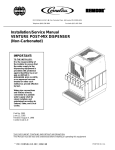
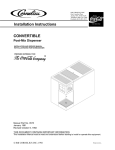
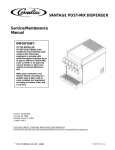
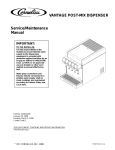
![Service Manual VA13 Carbonator [ 002818 ]](http://vs1.manualzilla.com/store/data/006013608_1-0f8f87056a0ab013b1dd01dac3912d47-150x150.png)
